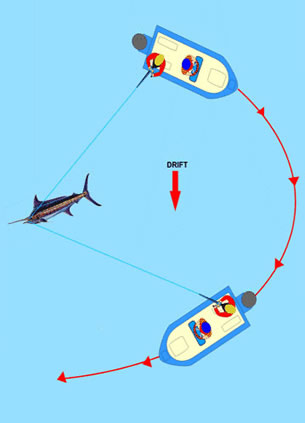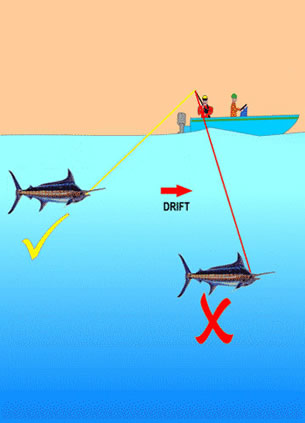04. Fighting Fish: Boat Handling
Between The Lines - Ch: 12 Fighting Fish
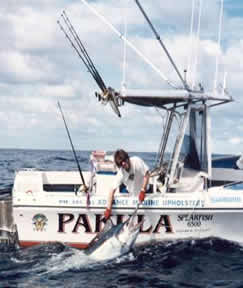 Fig 1
Fig 1
At last, we are hooked up and that reel is screaming! The discussion on fighting fish is often from a boat handling point of view with little consideration given to angling techniques. Indeed many boat handling tactics almost eliminate any contribution by the angler except winding in slack line at an exhausting speed. There's an often coined saying that a good skipper can compensate for a bad angler but an expert angler cannot compensate for a bad skipper. This somewhat belittles the contribution angling skills can add to the team effort. In the following, we'll take on the attitude that the ideal situation is where skipper, angler and the rest of the crew know what they are expected to do and when they are expected to do it. If each member of the team has practised exercises and participated in the discussions, there's a good chance all that follows will be quite simple to understand and easy to apply.
The actual number of crew is not relevant in this discussion. If there is a large crew then each member has less to do than a smaller crew does where each member of the team will have more to do. In the case of a one-man crew, the solo angler will have to do everything. (Fig 1) Regardless of the numbers involved, the same routine of tasks and their order of priority is similar in all cases.
Just as the number of crew is not really relevant the size of the boat or its engine type and number is also of little consequence. This is because the maneuvering while fighting the fish can be done going forwards, backwards, or both, though mainly in the direction the boat maneuvers best. (Vid 1)
Vid 1
This is the real thing, not an exercise; there are certainly some significant differences that you will become aware of instantaneously. The main one is that both the fish and crew are likely to be in a state of panic, which can easily turn to disaster. Without a doubt, there is enough to fill several chapters on safety when hooked up though they are unlikely to be read. Although dealt with previously it is worth going through a few sequences once more. Hopefully, notice will be taken of the following.
There are several key times where things can go wrong, remembering accidents are incidents that were not supposed to happen, and most are avoidable. When clearing the gear to ensure no hooks are on the deck at any time. When you hold a rigged lure, hold it by the head so the lure and hooks don't swing on the leader until it is put away and also ensure the leader is stored out of the way as well so it cannot tangle in someone's feet as they walk past. Whenever you are moving around the deck, check the path is clear.
When handling tag poles and gaffs, hold their heads above head height or over the side of the boat until they are used. They are both dangerous in use. Don't stand behind someone gaffing or tagging as a pole in the face can inflict major injury. Just as importantly after they have been used stow them safely away. Finally, when tracing a fish or using a flying gaff there may be loose leader or rope on the deck which can tighten in a microsecond. Ensure there is a path for it to straighten if the traceman or gaffman let them go, without any risk of someone getting caught in a loop or jammed between the leader or rope and the side of the boat. To help overcome this, going barefoot will help you feel if you are standing on leaders or ropes, but you still need to take note of loose loops and coils plus the tendency of leaders and ropes to spring into coils when slipping through hands. There are many more factors that are specific to how well the boat has been set up to clear gear and store it and how practised the crew is in these routines. At all times safety of all the persons onboard is of paramount importance.
Okay, let's get back to the exciting part of all this. That fish we hooked at the beginning of the page has probably spat the hooks by now, however as we've found the spot, the skipper has made another run over the same spot in the same direction and bingo, we've had another aggressive strike, hooked up and that reel is screaming again. What happens next is really very easy, and the priorities and sequence are quite logical which is fortunate because if you are at all human the excitement and adrenaline levels will be quite high to say the least.
The first priority is the fish and from now on, everything is centred on it. The line must be kept as tight as possible through these initial stages and indeed, throughout the whole fight. It is important to note that the fish is probably not hooked on this first run, and may not be hooked until it opens its mouth and lets the lure and hooks slide into the jaw. Marlin jaws are rough and designed to hold onto prey. Strike drag is unlikely to be enough to pull a lure or leader through a closed marlin mouth.
The angler should get the rod out of the holder as soon as practical to get control of the rod in case the fish lunges at the boat. If it does the angler should wind as fast as possible while the skipper drives away from the fish. Apart from that scenario, there's not much that can be accomplished through the initial stages of the fight until the fish has at least finished its first run. You can even keep at trolling speed for a few seconds in hope of hooking another fish that may have been excited by the first hook up.
In the case of stand-up fishing, the angler should already be wearing their gimbal and harness, and if not they should wait until things settle down before putting them on, as during this period the rest of the crew should be clearing the other lines and teasers from the water. When fishing with heavy tackle and a chair the angler should get into it and get clipped up in the harness as soon as possible and one of the crew should be available to steer the chair as soon as the angler is in it. Often the job of steering the chair may be given to the newest crew member or a visitor, freeing up the experienced crew to clear the other rods and gear.
The sequence of clearing the gear is to clear the closest gear first, that is teasers, short corner, long corner and so on. If the fish has taken off in a certain direction, the lines that may get crossed are cleared as they logically take priority.
As soon as someone is free from clearing the gear, they can get the gimbal and harness for the angler and help get them on and adjusted, though of course, they should have been pre-adjusted earlier. While the angler is getting set up they will not be able to control the rod or the fish so the skipper should keep the pressure on the rod by driving slowly away from the fish.
If at any time there is a danger of running out of line the boat can chase the fish to recover line by going forwards after the fish with the angler to the side of the boat. You can do this simply by moving rods that have not been cleared away as yet out of the angler's way. In fact, some teams don't clear any gear until the forward chase is underway in the hope of hooking more fish.
Once the gear is clear, the main fight can start. The boat may go after the fish to recover line, but the most important maneuver is to get into the position that will put the most pressure on the fish and least on the angler. This position is where the boat is drifting away from the fish, usually down current, but in rough weather, it may be downwind if the wind has more effect on the boat than the current.
|
|
|
|
Fig 2 |
Fig 3 |
The second aspect is keeping the angle of the line to the fish high in the water by positioning the boat relative to the fish's position. If the angle decreases below 45 degrees drive the boat down current away from the fish. As long as you can maintain this position, that is, down current with the line above 45 degrees you can stay in control of the fight.
At times, you may need to reposition by moving the boat several hundred yards if the fish has made a screaming run down current. (Vid 2) However, as long as you are gaining line and getting closer to the fish then the relative position of the boat and fish is not that important until you either end up in a stalemate or get close to the fish at which time it is very important to get into the correct position.
Vid 2
Apart from repositioning the boat, the only other consideration is closing the gap between the angler and the fish, with the boat on a course to intercept the fish. (Fig 4) How fast the angler can wind while maintaining pressure on the fish will dictate the speed of the boat. The greater the pressure the angler can apply smoothly the greater the chance the fish will hold on the surface without diving, although often the fish will dive as the boat gets closer.
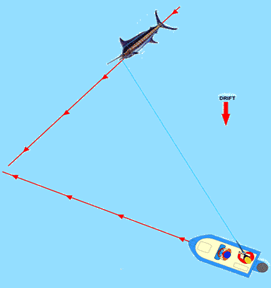 Fig 4
Fig 4
To get the fish back to the surface and the line angle up, slowly drive down current away from the fish with the angler applying as much pressure as possible. The fish should react by coming back to the surface, at which time the boat should resume the interception course. (Vid 3)
Vid 3
While all this is going on the crew will have stored the other tackle, leaving the deck clear for action. They should also have tag poles and/or gaffs, bill ropes, and whatever is required at hand and be wearing their tool belt with cutters on and gloves. The speed of action and efficiency can play a major role in success. The faster the crew can convert the deck from a trolling configuration to a platform for battle the better. At times, good management or sheer good luck may present an early chance at the fish. Unless the boat and crew are ready, the advantage may be lost.
In the initial stages when the fish is running the skipper can see what is going on quite clearly, but once the fish settles down the skipper cannot see some very important aspects. Usually, the angler has their back facing the skipper and no matter how much the angler yells it is unlikely the skipper will hear them over the engine and wind noise. It is now that one of the crew becomes the link between skipper and angler using hand signals or arranged calls to let the skipper know the speed at which they are losing or gaining line, drag settings, fish direction, and if the angler is tight to the fish and keeping up with the boat speed if they are heading towards the fish.
It is through the crew that the skipper can ensure the angler receives and understands information as to what he is about to do regarding direction and speed, especially if he has been moving the boat down current trying to plane the fish up. Often this is a very slow maneuver followed by a surge towards the fish, especially if the fish looks tired and comes very close to the surface. The angler should be warned as should everyone else so they don't get knocked off their feet as the boat lunges, and the angler should be prepared to gather line as quickly as necessary to maintain pressure on the fish. (Vid 4)
Vid 4
Throughout the whole fight, the boat is either going forwards or backwards, never in neutral from the time of hook-up to the time of release.
Though we call all these maneuvers and team tactics ‘fighting' they are really more like leading in a waltz, each time the fish makes a move the boat and angler will react to it. Many of these moves are simple, either driving to intercept the fish if it is near the surface or driving away down current if the fish is deep to plane it back to the surface. Often these moves are quite repetitive as you do the Big Fish Waltz. (Fig 5)
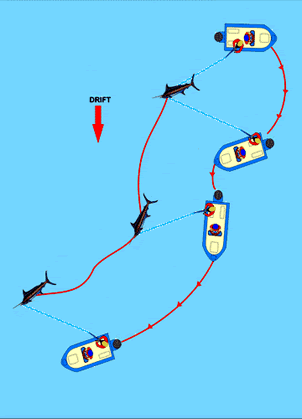 Fig 5
Fig 5






